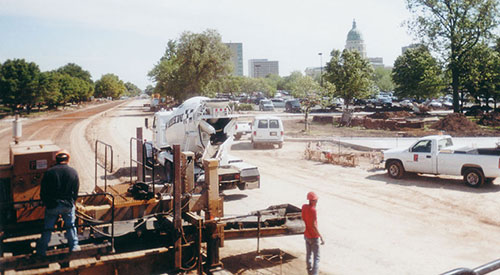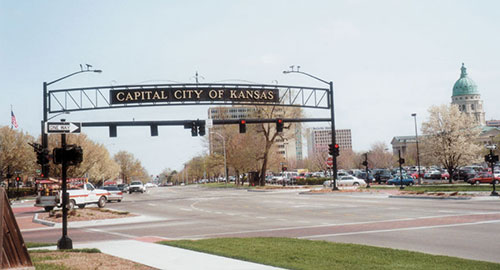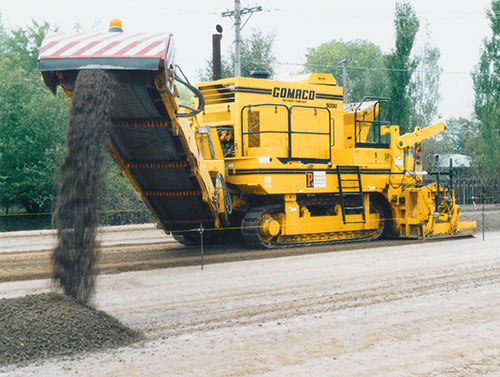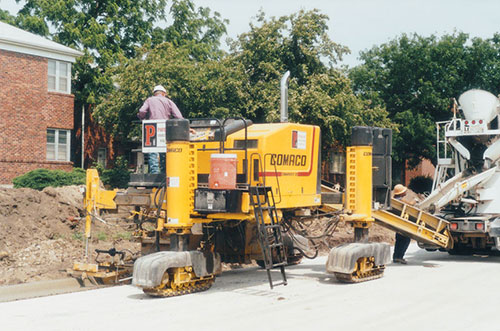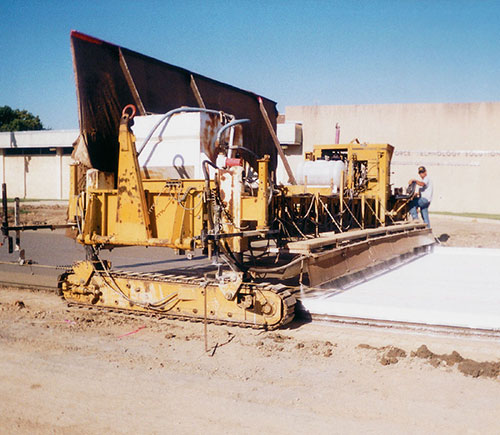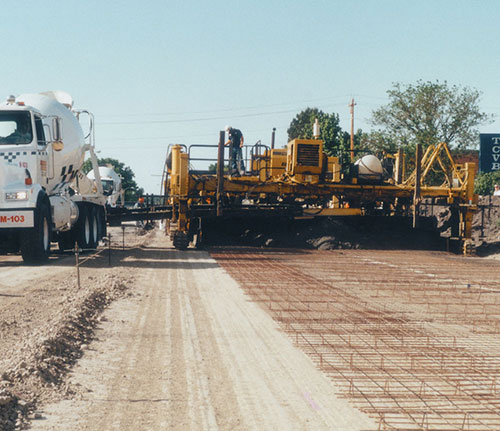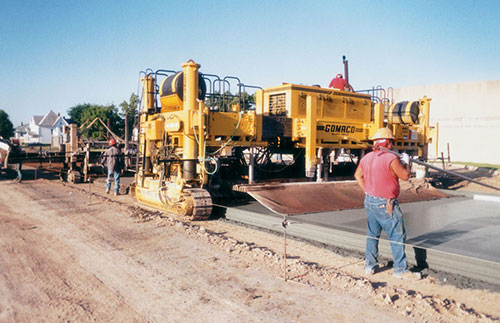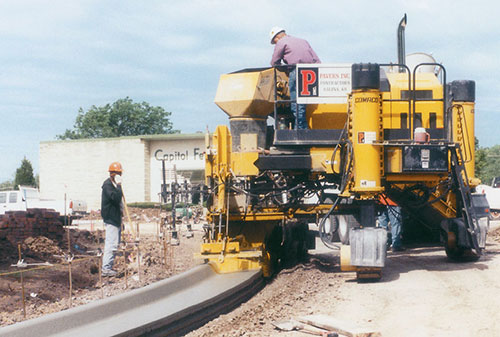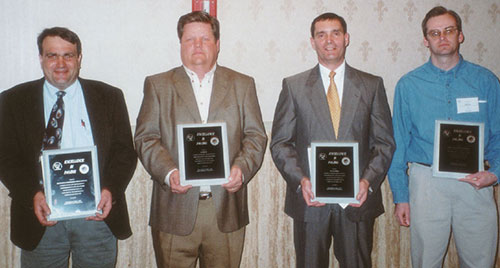GOMACO World Index --- GOMACO World 29.2 - June 2001
Fast, Smooth and Award Winning
The American Concrete Pavement Association (ACPA) Awards are designed to honor quality concrete pavements constructed each year. This sentence is clearly stated at the top of the Missouri/Kansas award nomination form submitted by Pavers, Inc., a contractor based out Salina, Kansas.
Representatives from Pavers, Inc., were in Kansas City, Missouri, March 8, 2001, to receive their ACPA paving award for the Major and Minor Urban Arterial category. Their work on southwest Topeka Boulevard, 11th to 15th street in Topeka, Kansas, earned the award for its early completion, pavement smoothness and quality workmanship.
The project was scheduled to be completed in five phases. The first two phases of the project included all the work between 11th and 13th streets and was over 50 percent of the total project requirements. The two phases had to be completed in 90 days and carried a penalty of $3,000 for each additional day.
The entire project called for the removal of parts of the existing southwest Topeka Boulevard and side streets. The boulevard is the main north/south road to and from downtown Topeka and the city wanted to add left-hand turning lanes along the route to help ease traffic congestion.
Project leaders decided to detour traffic around the construction site and close the road completely. Work began on April 10, 2000, with the removal of the existing sections of the boulevard and side streets.
A new six inch (150 mm) lime-treated subgrade was put in and a GOMACO 9000 trimmed the final grade.
"Once we got all of the lime-treated subgrade done, we went on to the four side streets and we poured all the curb and gutter first with our new generation Commander III," Neal Saskowski, project manager for Pavers, Inc., said. "Once they started doing that, we started on the mainline trimming and getting it ready. Then, on days we'd have it ready, we'd just go ahead and pour the mainline."
Pavers, Inc., slipformed the new roadway with a GOMACO paving train which included a PS-30 placer/spreader, GP-2600 two-track paver, and T/C-600 texture/cure machine.
"Buying that placer/spreader made life a lot easier on me," Saskowski said. "Before, we were always just dumping out in front of the machine. Trying to keep a consistent head in front of the paver was nearly impossible. With our spreader, we can control that. We can adjust it by raising or lowering it and it helps us keep a consistent head of concrete in front of the paver."
A GP-2600 paver slipformed the new five-lane roadway. During the first phase, the slab was slipformed 22 feet (6.8 m) wide and formed the first two lanes of the boulevard.
The center turn lane was added next. A four-track Commander III was used to slipform the lane 12 feet (3.7 m) wide. The roadway was completed with the final two lanes slipformed 22 feet (6.8 m) wide. All of the sections were slipformed with a male keyway.
"We've always run a male keyway," Saskowski said. "I think our edge stands up better with the male keyway as compared to the female."
A T/C-600 texture/cure machine was used to apply a burlap drag finish and cure spray.
Tie bars were added later. Holes were drilled into the edge and the rebar was grouted in on five foot (1.52 m) centers along the length of the slab.
The new generation Commander III was then used to add the 29.5 inch (750 mm) curb and gutter to the slab.
The same concrete mix design was used for both the GP-2600 paver and new generation Commander III. A Class AAA concrete mix consisting of 50 percent rock, 50 percent sand and 602 pounds (273 kg) of cement was used to slipform the project. Retarder was added to combat hot summer temperatures in excess of 100 degrees F (38 degrees C). Slump averaged between 1.5 to 1.75 inches (38 mm to 44 mm).
With the first two phases of the project completed on time and open to traffic, it was time to begin the final phases. Phase three, four and five included all work between 13th and 15th streets. The plan originally called for the work to be constructed under traffic.
"The plan called for us building two lanes at a time 22 feet (6.8 m) wide. We'd build the two southbound lanes, get them done and put traffic on them and then build the two northbound lanes, get them done and put traffic on them, and move on to the center lanes," Saskowski explained. "We offered them a change order that we could save them approximately 30 calendar days of contract time if we could just close the whole thing off and continue to use the existing detour."
A change order was issued and Pavers, Inc., was allowed to keep the road closed and continue construction. In the end, the street was opened to traffic 55 calendar days ahead of the original date.
The entire project had a total of 2.35 miles (3.78 km) of lane miles and a total of 21,804 yd2 (18,230 m2) of concrete pavement.
The state of Kansas uses the zero-blanking band for rideability to measure smoothness. The spec allows an average profile index of 45 inches per mile (710 mm/km) or less on roadways with a posted speed of 45 mph (72 km/h) or less.
The profile index averaged 21 inches per mile (331 mm/km) and earned them bonus for a majority of the project. Smoothness bonus is paid for rides of 25 inches per mile (400 mm/km) or less.
"On the second half of the project, ride averaged ten inches (261 mm)," Saskowski said. "It made a nice, smooth riding street."
The nomination form asked what specific detailed steps were taken to achieve and maintain smoothness. The answer: consistent concrete delivery, consistent concrete slump, consistent head in front of the paver, consistent thickness, consistent paver movement, consistent vibration, and very tight and accurately set stringline.
"Meier's Ready Mix provided us with consistent concrete and good delivery. We had a really good dirt contractor in Schmidtlein Excavating of Topeka. One thing we did, from the time their dirt was close until the time we poured, is worked off the same stringline. Stringline grades and supports were set every 25 feet (7.62 m) and it was our guidance all the way through," Saskowski explained. "The PS-30 has been a lifesaver and I think it's the main reason our rides have been that much better. We can consistently get good ride on all of our projects with our placer/spreader, despite the quality of the concrete delivery."
The project was opened to traffic on October 5, 2000. A gateway sign now hangs over the new boulevard welcoming drivers to Topeka, the capital city of Kansas. It showcases the capitol building and the successful completion of the project.
Subscribe to Receive GOMACO World Magazine
